汉语 》 shuō wén jiě zì Shuo Wen Jie Zi 》
juàn yī
xǔ shèn Xu Shen
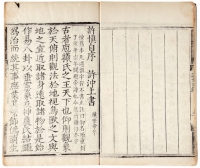 说文解字 卷一 说文解字 卷一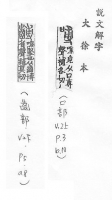 说文解字 卷一 说文解字 卷一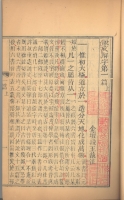 说文解字 卷一 说文解字 卷一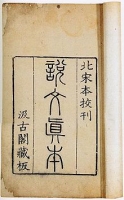 说文解字 卷一 说文解字 卷一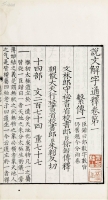 说文解字 卷一 说文解字 卷一
卷一
序
古者庖羲氏之王天下也,仰則觀象於天,俯則觀法於地,視鳥獸之文與地之宜,近取諸身,遠取諸物;於是始作《易》八卦,以垂憲象。及神農氏,結繩為治,而統其事。庶業其繁,飾偽萌生。黃帝史官倉頡,見鳥獸蹄迒之跡,知分理之可相別異也,初造書契。百工以乂,萬品以察,蓋取諸夬。“夬,揚於王庭”,言文者,宣教明化於王者朝庭,“君子所以施祿及下,居德則忌”也。
倉頡之初作書也,蓋依類象形,故謂之文。其後形聲相益,即謂之字。文者,物象之本;字者,言孳乳而寖多也。著於竹帛謂之書。書者,如也。以迄五帝三王之世,改易殊體,封於泰山者七十有二代,靡有同焉。
《周禮》:八歲入小學,保氏教國子,先以六書。一曰指事。指事者,視而可識,察而見意,“上、下”是也。二曰象形。象形者,畫成其物,隨體詰詘,“日、月”是也。三曰形聲。形聲者,以事為名,取譬相成,“江、河”是也。四曰會意。會意者,比類合誼,以見指撝,“武、信”是也。五曰轉注。轉注者,建類一首,同意相受,“考、老”是也。六曰假借。假借者,本無其事,依聲託事,“令、長”是也。
及宣王太史籀,著大篆十五篇,與古文或異。至孔子書六經,左丘明述春秋傳,皆以古文,厥意可得而說也。
其後諸侯力政,不統於王。惡禮樂之害己,而皆去其典籍。分為七國,田疇異畝,車涂異軌,律令異法,衣冠異制,言語異聲,文字異形。秦始皇帝初兼天下,丞相李斯乃奏同之,罷其不與秦文合者。斯作《倉頡篇》。中車府令趙高作《爰歷篇》。大史令胡毋敬作《博學篇》。皆取《史籀》大篆,或頗省改,所謂小篆也。
是時,秦燒滅經書,滌除舊典。大發吏卒,興戍役。官獄職務繁,初有隸書,以趣約易,而古文由此絕矣。自爾秦書有八體:一曰大篆,二曰小篆,三曰刻符,四曰蟲書,五曰摹印,六曰署書,七曰殳書,八曰隸書。
漢興有草書。尉律:學僮十七以上始試。諷籀書九千字,乃得為史。又以八體試之。郡移太史並課。最者,以為尚書史。書或不正,輒舉劾之。今雖有尉律,不課,小學不修,莫達其說久矣。
孝宣皇帝時,召通《倉頡》讀者,張敞從受之。涼州刺史杜業,沛人爰禮,講學大夫秦近,亦能言之。孝平皇帝時,徵禮等百餘人,令說文字未央廷中,以禮為小學元士。黃門侍郎揚雄,采以作《訓纂篇》。凡《倉頡》以下十四篇,凡五千三百四十字,群書所載,略存之矣。
及亡新居攝,使大司空甄豐等校文書之部。自以為應制作,頗改定古文。時有六書:一曰古文,孔子壁中書也。二曰奇字,即古文而異也。三曰篆書,即小篆。四曰左書,即秦隸書。秦始皇帝使下杜人程邈所作也。五曰繆篆,所以摹印也。六曰鳥蟲書,所以書幡信也。
壁中書者,魯恭王壞孔子宅,而得《禮記》、《尚書》、《春秋》、《論語》、《孝經》。又北平侯張蒼獻《春秋左氏傳》。郡國亦往往於山川得鼎彝,其銘即前代之古文,皆自相似。雖叵復見遠流,其詳可得略說也。
而世人大共非訾,以為好奇者也,故詭更正文,鄉壁虛造不可知之書,變亂常行,以耀於世。諸生競逐說字,解經誼,稱秦之隸書為倉頡時書,云:“父子相傳,何得改易!”乃猥曰:“馬頭人為長,人持十為斗,虫者,屈中也。”廷尉說律,至以字斷法:“苛人受錢,苛之字止句也。”若此者甚眾,皆不合孔氏古文,謬於《史籀》。俗儒鄙夫,翫其所習,蔽所希聞。不見通學,未嘗睹字例之條。怪舊埶而善野言,以其所知為秘妙,究洞聖人之微恉。又見《倉頡篇》中“幼子承詔”,因曰:“古帝之所作也,其辭有神僊之術焉。”其迷誤不諭,豈不悖哉!
《書》曰:“予欲觀古人之象。”言必遵修舊文而不穿鑿。孔子曰:“吾猶及史之闕文,今亡矣夫。”蓋非其不知而不問。人用己私,是非無正,巧說邪辭,使天下學者疑。
蓋文字者,經藝之本,王政之始。前人所以垂後,後人所以識古。故曰:“本立而道生。”知天下之至賾而不可亂也。今敘篆文,合以古籀;博采通人,至於小大;信而有證,稽譔其說。將以理群類,解謬誤,曉學者,達神恉。分別部居,不相雜廁也。萬物咸睹,靡不兼載。厥誼不昭,爰明以喻。其稱《易》孟氏、《書》孔氏、《詩》毛氏、《禮》周官、《春秋》左氏、《論語》、《孝經》,皆古文也。其於所不知,蓋闕如也。
"Dictionary" referred to as "the text says," is the first systematic analysis of Chinese characters and the etymology of the word elegant book. Xu Shen a, as in the construction of light Andi first year (121 years). The original fourteen, a Syrian head, body, mainly by Seal Script to close 9353 words, and classical, Zhou Wen and other variants with the text of 1163 words to explain the thirteen thousand words. In the popular book by channeling chaos in the stack, now quite different from the original book. First book, Radical layout method, followed the letter of the word for future generations. Book of ancient texts, ancient literature and ancient history of contribution to the great. Research in the Qing Dynasty, "said the text" has become specialized knowledge, it's there for dozens of note.
"Dictionary" - basic information
Title: "Dictionary" (the "Shuo Wen")
Author: (Chinese) Xu Shen essays, (Song) Calibration Xu Xuan
Publisher: Zhonghua Book Company
Publishing time :2004-2-1
Pages: 390
"Dictionary" - Author
Xu Shen Xu Shen (about 58 years - about 147 years), Zi Shu weight, Han Runan Shaoling (now in Henan Yancheng Xian) people, the "Five Warriors by Xu Shu Zhong" of appreciation. He is known by scientists Han, text scientists, linguists, is the pioneer of Chinese Characters. In AD 100 (Han Yong-yuan Dili ten year) the "Dictionary", is the first dictionary.
House has served as Qiu Xu Shen Ji Jiu, where he studied classics master Jiakui. 21 years after his book into the "Dictionary", sum 540 radicals of Chinese characters. Xu Shen also with a "different meaning of the Five Classics", "explanations of Huainan Honglie" and other books, has been lost. Xu Jinjing said: Uncle severe, were cautious, Runan Shaoling people. Of pure Benedict, less erudite classics, often pushing Jingzhi Ma Rong, the language of the time people said: "" Five Classics "Hsu Shu Zhong unparalleled." Attack Cao for the county, held Xiaolian, then moved inter Xiao long. Died at home. Early, be careful of "Five Classics" legend rank different, so essays for "Five by objection." Yong Yuan Shi Youer years (100), before making the "Dictionary", order said: "In ancient package of Wangtian Xia Xi's also, saith the elephant in the day, overlooking the view of law in the land, as the birds Articles and to the wish of the last taken from the body, so before making the "easy" gossip, like to hang Constitution. and rope for the governance of Shennong system the event, Shu industry of its complex, decorated for the initiation. Huangdi of the positions Jie, see traces of distant hooves of animals and birds, can be known relative to other points of different reasons are, first made the book contract. "hundred public to qe, million products to detect, cover come from the husband," "Fu Yang Yu Ting." Man who made missionary Ming court of the king, a gentleman so Shi Lu, and the world, ranking Germany and the bogey as well. Changjei for the beginning of the book, covered by class of pictographic, so that the text. then shaped pan benefits, namely that the word . Man who of the images are; character who has made more than Ziru the Baptist. with all the books in the Bamboo and Silk, who like the book too. and until the Three Kings and Five Emperors of Shi, Gaiyi various body. sealed with seven persons in Taishan second generation, have the same extravagant Yan. "
Construction light year (121), book into. Received nine thousand three hundred and fifty three words; heavy paper one thousand one hundred and sixty three, points in the five hundred and forty. Disease when the offer was published at the Emperor Qian Zi Chong. Death, burial Yancheng Xian Xu Ji Shi Township, Village East. Gao tomb has five feet ten, forty a diameter of eight feet. Local people said: "Japan will move a PCT, three feet long night." Absurd also, anything too get out of the mound. "Han" Chan said: "Sven has not hills, but also have bearing. Tu Do triage, specialized and Hing. Jing Shu Shu will, through Ae phase sign. Golden without, who clarified origin." To clear, the age of Zhong Ding months after the date of the magistrate, school official to the memorial tomb of Master Xu, line three call-in ceremony of kneeling. Forty six of Kangxi (1707), Yancheng Xian magistrate Wende Yu Li, "Hau Lim Hui Tomb of the public," the monument. Dynasty period (1875-1908), Yan Cheng Li Wang Fengsen magistrate, "Master Xu monument from the Temple worship." Thirty-seven years after the founding of New China (1985), Xu Shen of the first meeting, the legislature, "Xu Shen gravestone rehabilitation in mind." Shiyou Er Zhi Bai hundred and eighty strains, this deposit has three hundred and fifty, the March of the few also. Currently, Xu Shen shrine located in Yancheng District, Luohe Xu Shen Road, Luohe four high (former Yancheng a high, Provincial Yan in the) next.
Chinese is the world's most ancient text, is the oldest hieroglyphics. Today, it is found that the ease of character entered into the computer, is the world unmatched by any kind of text, when people began to keen to study Chinese characters, the first thought of Xu Shen.
"Dictionary" - Book Description
"Dictionary", referred to as "the text says," is the first systematic analysis of the glyph and the etymology of the word elegant book. Text book included Zhuanwen received (ie Xiaozhuan), (Ancient wall in the book), Zhou Wen (Seal), or body, customs body. "Culture" refers to the overall pictographic ideogram, "word" refers to the guitar body shaped table with the table fit the sound of the word, so Xu Shen a "Dictionary" as the title, and their offspring are often referred to as "the text said" . Jian Xu Shen in Eastern Han Andi Light year (121) written. It laid the basis of ancient Chinese characters the book.
The original fourteen, a Syrian target. The main body of the Xiaozhuan, received nine thousand three hundred and fifty words, but also other classical ﹑ Zhouwen weight paper one thousand one hundred and sixty different words, interpreting the word one hundred thirty-three thousand four hundred and forty. Spread in the book, many times from channeling chaos, now the school is determined by Xu Xuan Song, and many out of the original book, Xu Zhi heavy to articles will each be divided into upper and lower volumes in a total of thirty volumes, revenue nine thousand four hundred and thirty word, re-word the text one thousand two hundred seventy-nine, explain one hundred twenty-two thousand six hundred ninety-nine words. The book changed the week ﹑ Qinzhi Han compilation method of the book of words, word about the closing statement prepared for the four forms of ﹑ Seven Rhyme, the first arrangement of the radical method, divided into five hundred and forty. Hsu has summed up the former "Six" theory, creating a systematic approach to explain the text, to explain the meaning of words, sub-analysis of physical structure, and then explain the pronunciation. Shape analysis method, is not the letter of the word before. The filing of the ancient book of ancient literature and ancient history have a significant contribution to research. But that solution is also complex and subjective assumptions and superstitions, need to refer to bones ﹑ ﹑ stone wood simple validation of text discussions. "Said the text" This a great book, the struggle is generated by the school. New Text Classics and Classical Learning Han academic dispute is the most important areas of thought a debate. Qin previous books are used when the text written by the six countries, six countries, said Han language as a "classical" by the books written by classical as Classical. Qin Shi Huang for the needs of obscurantism, these ancient words written with "Poetry", "book" and other books burned. Western Han Dynasty, some older scholars dictated from memory the Pentateuch to the disciples, disciples down with the official script. Han official script is the text passage, saying "New Text", with New Text written by the book, called New Text. Have been discovered by the ancient text was written by the book. So that scholars in the Han New Text to be divided into the classical scholars and scribes. The difference between the two factions is not just based on the performance of classical studies and text in different versions, but more importantly showed how to make the classics of the feudal rule of service. New Text scholars of classics like far-fetched explanation for the spread superstition and science of divination; Ancient scribes stressed to read classics, and truly understand the essence of Confucianism, and Explanations of Things for this focus, attention to linguistic facts, more concise simplicity. Xu Shen belongs to the Classical School, he edited "the text says," is to use language as a weapon, and expand Classical Learning in the political and academic impact.
"Dictionary" - Concept Development
From a historical point of view
1, the text originated early. Although the pottery unearthed there something like the early text, but what does it really belongs to the era, how to know, remains to be further study. Therefore, today can see the earliest records of systematic Chinese writing is Oracle. From the Oracle development to the text on the bronze inscriptions. Spring and Autumn period to the six so-called classical: early Zhou Wen Qin, money on the text, the text on the pottery and more. To the era of Qin Shi Huang, the Qin Zhou Wen simple as Xiao Zhuan. Then developed into official script, cursive, running, really the book (that is, regular script, is the book.)
From the point of writing style
Xu Shen monument to the development of character deformation and potential changes. Deformation of the shape has changed; potential change has changed the writing strokes. Deformation such as the Ancient Bronze with six very different
, Xiaozhuan compared with the inscriptions, there has been a great change. Seal is a round pen mostly Xiaozhuan has been little change in official script changed dramatically, the round pen into a square pen. "Big," "Day" into a box shape from the circle. This development on the one hand about the complex tends to trade, simplification, such as the Seal, Zhou Wen to Xiaozhuan; the other hand can be seen by the monomer into a fit, with different phonetic radical become words. Tend to write about on the complex easy to reproduce on the word meaning from the shape to form the phonetic direction. Representative of the earliest pictures first, the image of the picture as a text becomes simplified pictograph. Also refers to things, "said the text" move "on" and "down" for example, because nothing can be like, so it means something. There knowing, knowing is generally fit, such as "phase", is composed of two independent synthesis of knowing. This method is sometimes the poor, was made to phonetic development therefore has shaped the direction of the sound. You You turn injection, under the guise of, together several previous six books. Explanatory, "Wen said Syria" talk "building class a, .. always test it." There are various different interpretations of their predecessors. More accurate is the Liu arch of the argument: "From the Meaning of Health figures that the transfer note, to the word photo number meaning that the pretext; with the tone _set_ words, that the transfer note in accordance with sound in mind the word that the pretext." Zhen, Duan speaking turn is the Mutual Notes
, No, not the text Ziru each method of training. Defined in the Private legislation under the guise of not words, homonyms under the guise of, take a word, two different words. Transcription is the phonetic
, The name is phonetic, so the meaning is shaped to form the phonetic direction. Word use, word polymorphic
(Or body, the different wording of a word) slowly tend to fixed. Historically, the ancient words of the other characters present.
Finals of evolution. Should first understand the sound, rhyme is a system (system), is not chaotic. A language of initials, finals, there are several sub-classes of the number; Finals with a regular, is the system. For example: Modern Chinese ordinary '.. some with iy (iy medial or rhyme) juxtaposition, not juxtaposition with the AO. Finals of evolution is some development in this change within the system. Or from the simple to the complex evolution, such as the ancient "end through the _set_," under certain conditions, the development of "knowledge Toru Cheng" and "according to wear bed." Or from complex and simple such as "blue" is to the mother and the "prison" is to see the mother, the ancient voice calls are consonant consonant clusters
kl2. Why ancient consonant clusters? Such examples are not the individual. For example: "shu" from such sound. A word can have two pronunciations, such as the "rate" shuài, lǜ, the first two consonants, under certain conditions, the development of some preserved in front of consonants (such as "prison"), some preserved after the consonant (such as "Blue"). In addition to harmonic sound, the comparison from the Sino-Tibetan cognate can also be seen ancient consonant clusters. People do not agree with this. Fujian Dialect different. Due to political, economic, there are different times.
Phonological system from the Chinese perspective of the development of voice
Can be divided into several stages (p eriod): ancient, medieval, early modern, modern, modern. Ancient and can be divided into early (proto-Chinese), late (archaic Chinese). Time
To some stretching before and after behalf, this is a trend. , For the ancient pre-Shang Ming, cross cultural relations in all aspects, Dialect differences gradually by the integration, tends to a not general. Should be classified in different stages of the history of Yuan and Qing is the sound of modern party There are ancient, and is one of the earliest Chinese language, the dialect but the difference is the ancient Zhou and Qin late; if more than the ancient Zhou and Qin Now for the modern. REN, the ancient Han Dynasty can be said to be the later. For the Middle Wei, Tang, Song for the Late Antiquity branch only. Some American scholars believe that the Min dialect of Chinese is not the same with the early
, Have their own native language original of Min. Yue, Wu, then the north is the evolution from one of the early Chinese. Because a language can not be
To compare just from the voice, depends on its grammar and vocabulary. Min Dialect is also a syllable language, not a lot of form (p hono log2
ical) changes, grammatical structure is consistent with other Chinese dialects, tones can be related. Glossary of evidence for more, but some words if not the north. Between different ethnic groups and there are issues that affect each other, absorb some of the other national languages vocabulary. Language development is also uneven, and some faster, some slower. Dialect development is staggered, and some consistency. The same is relative, not absolute. Entering the North, then in general no, but if there Shanxi Tone, tone is different, and some have five, six tones.
In short, to build on the phonological evolution of two concepts: one is the different ancient and modern times, one side sounds different.
The development of semantic
The meaning of the text has the original meaning of a change in meaning. The original meaning of the text from the early form that reflected on the image is taken and what it represents meaning. Variable defined using the text in the table means that played by the development and changes. Change is multifaceted, escape, metaphors, by the righteousness of the original meaning changes in terms of meaning. Of semantics, can not be seen in isolation. First, look at the word in the earliest literature is how to tell the (the first appearance), some can not see from the shape alone. Second, we must root
"Dictionary" - the main content
"Dictionary" is the first great impact on future generations and a dictionary, but also China's first Chinese dictionary arranged by radicals. This book was written in Dili Yongyuan years (100), to build light Andi first year (121). Original has been lost. Spread to most of today's version of the Song Dynasty, or annotated version Duan Qing Dynasty. Original to Xiaozhuan writing, verbatim interpretation of the font source. Xu Shen writing, the dedicated to the Emperor Han'an. The book is divided into 540 radicals, to close the word 9353, while "heavy paper" that variant 1163, a total of 10,516 words.
"Dictionary" Xu Shen explained the title:
CJ is also the beginning for the book, covered by class of pictographic, so that the text. Subsequently shaped pan benefits, namely that of the word. Man those images of this; character who has made more than Ziru the Baptist.
"Dictionary" Book Film (Pavilion Books Pingjin this)
"Dictionary" of 15 volumes, including Volume 1 sequence present. Xu Shen in the "Dictionary" elaborated in the system of Chinese characters defined in the Private Law - Six.
"Dictionary" is listed first Xiaozhuan the style, if different from classical and Zhou Wen, listed in the back. Then explain the meaning of the word, and then solid shape with the words or the relationship between pronunciation. "Dictionary" is arranged according to radicals in the body similar to the principle of similar meaning, or arranged.
Xiao Zhuan as the main book to analyze the shape structure, depending on the radical, the separation for the 514, started the "one" part, and finally, "Hai" department. Where the radical or stroke font characters are attributed to a close, give the radical a first home. Arranged in the order of the Ministry and the Ministry of strokes and radicals in general to the physical structure is similar to the guidelines on the sequence of strokes with similar structures. Xu 514 part 14 books, not as a head end of this brochure and Syria, it is 15. The arrangement of each word in a three main principles:
① the meaning of the text in the application is good, good in front of the column are derogatory, bad columns in the back;
② are specifically within the terms of a column in front of the term belonging to the ordinary things listed in the back;
③ within a word, meaning a similar ordinal classes together in order to spider. Zhuanwen made under the first meaning of each, then made physical structure, or that the last time, if a.
"Dictionary" - the value of contributions
"Dictionary" is the first systematic analysis of Chinese characters and learn the source of the word elegant book is the most widely circulated Chinese language will be borrowed books.
This book summarizes the Qin and Han literature results, to save the Chinese people's shape, sound and meaning, is the study of Oracle, inscriptions and ancient sound, and training essential to visit the bridge. In particular, "said the text" on the interpretation of the meaning of words generally save the most ancient meaning, the meaning of understanding of ancient books more helpful.
"Said the text" outstanding contributions to the book can be summarized as the following four points:
1. Xu Shen create radical is one of the great creation. Chinese characters are represented with physical meaning, therefore, to analyze Chinese Symbols, Chinese characters are all characters to be classified by their righteousness, which is the work of Chinese scientists, the work by Xu Shen was first completed. "Said Wen," was divided into 540, in addition to individual radicals can also be combined with the adjustment, in general, that are reasonable and are in line with created characters intent. Xu Shen in the arrangement of the order of 540 taken great pains to form rows with similar or similar, which is equal to 540 is divided into several categories, which can help readers gain a deeper understanding of the meaning of character, a more accurate understanding of the meaning of words. Each word belongs to the arrangement is not chaotic, but according to the principle of phase from class. Specifically, in three ways: First, words of similar meaning row together; second, meaning the top is the positive side, in the back row are negative; Third, the top edge of proper nouns, common nouns ranked behind. 540 Xu Shen created the word radical and an arrangement among the various methods, are learning from the perspective of the text, this method can reflect the arrangement of radicals and the radicals, the meaning between words link, which Law and later the word from the prosecution point of the segment and classified by the number of strokes is very different.
4. Six of the characters. Before the Xu Shen, a basis for the Six CJ defined legends. Argue that the modern text, the book is the sixth rule summary Chinese Character, rather than before the birth of Chinese characters defined in the Private mode. Before the Xu Shen, only the name of the Six: pictographs, indicatives, knowing, shape the sound, turn injection, under the guise of, not specifically addressed, but not for large numbers of Chinese characters. Xu Shen's theory of the development of six books, six books clearly defined and put into practice six books, one by one analysis, "said Man," which included the 9353 Chinese characters, the history of the development and research in the history of Chinese characters has a carrying forward significance, thus establishing the character of the national style, national characteristics.
"Dictionary" - its influence
Two thousand years, "Dictionary" is the first text book on science is the most authoritative book, it's the name of Xu Shen and his descendants to read ancient masterpiece as to explore the ancient culture of classical must essential bridges and key.
"Said the text" We Duan, "said the text" came later, and soon attracted the attention of scholars at that time, the classic often cited in the comment, "said Wen." Such as: Li Zheng Xuan Note III, Ying Shao, Jin Zhuo Note "Han", have invoked "the text says," to prove the meaning of words. "To the Northern and Southern Dynasties era, scholars have," said the text "has been more comprehensive understanding of the system. Provisions of the Tang Dynasty Imperial Examination to test, "said Wen." Since the Tang Dynasty, all the words book, phonology and exegetical notes in the book are based on the meaning of words, "said Wen."
"Said the text" came later, researchers uprisings. Qing Dynasty is, "said the text" of the peak period. Qing study, "said Wen," the scholar no less than 200 people, including dozens of experts who claim to many. Qing Dynasty, "said the text" of science, can be divided into four categories: First, is the collation and research work, such as strict to all ", said Wen school discussion", the money goblets of "Shuo Wen Jie Zi BOOKS COLLATION AND STUDIES interpretation," and so on; Second, on, "said the text" to remedy, such as the home of the wide hole, "said Wen doubt suspect," Yu Yue's "children Shan Lu," and so on; the Third, "said the text" a comprehensive research, such as Duan's "Shuo Wen Jie Zi Note, "Gui Fu's" Shuo Wen Jie Zi Explanation ", Jun Zhu sound," said Wen Tong training given sound, "Wang Jun", said textual reading "; its four predecessors or contemporaries Supplements scholars," said the text " research works, such as Yan Fu's chapter, "said Wen proposed school meeting," Wang Shaolan ", said Wen Duan _set_ up" and so on. The third most important of which, the four also claimed that "the text says Four." Each of the past to keep neighbor Dingfu, "said Wen," the books and other deals, "said Wen," the writing and the Oracle, inscriptions of the material and the "Explanatory Shuo Wen Jie Zi", and then compiled as a collection of left Yat "Supplement" is the book notes of the pool.
请欣赏:
请给我换一个看看! 拜托,快把噪音停掉!我读累了,想听点音乐或者请来支歌曲!
|
|
|